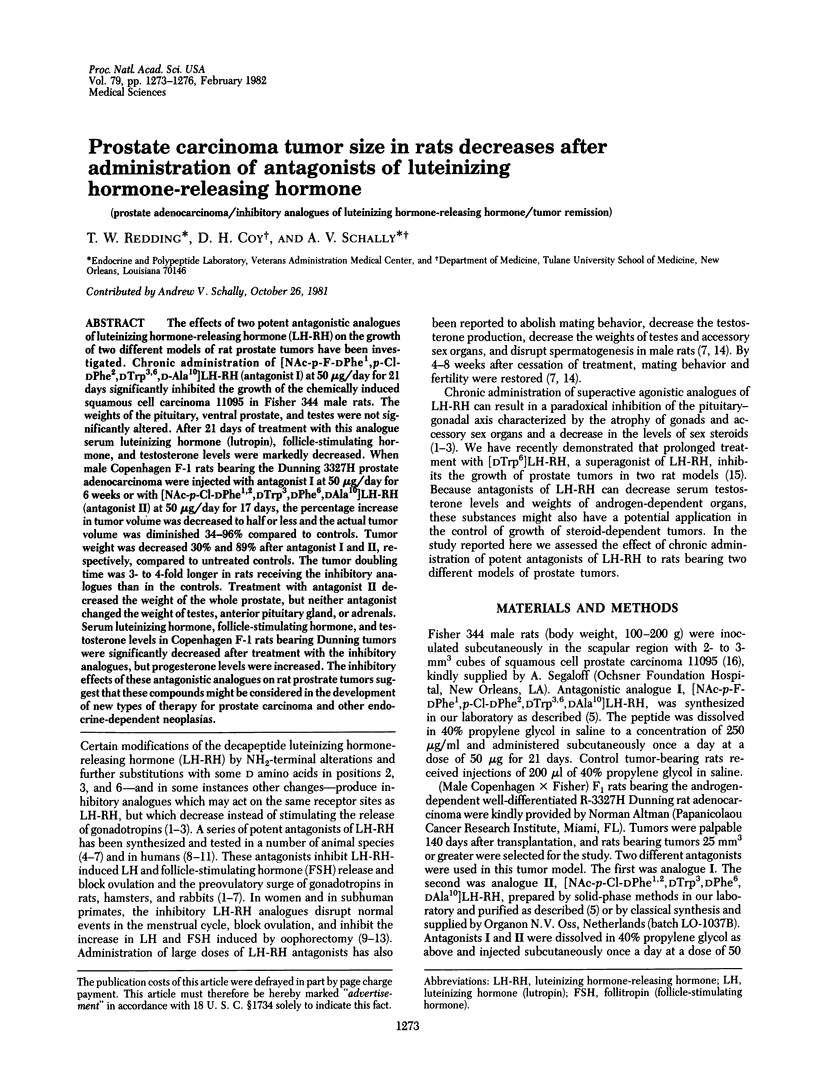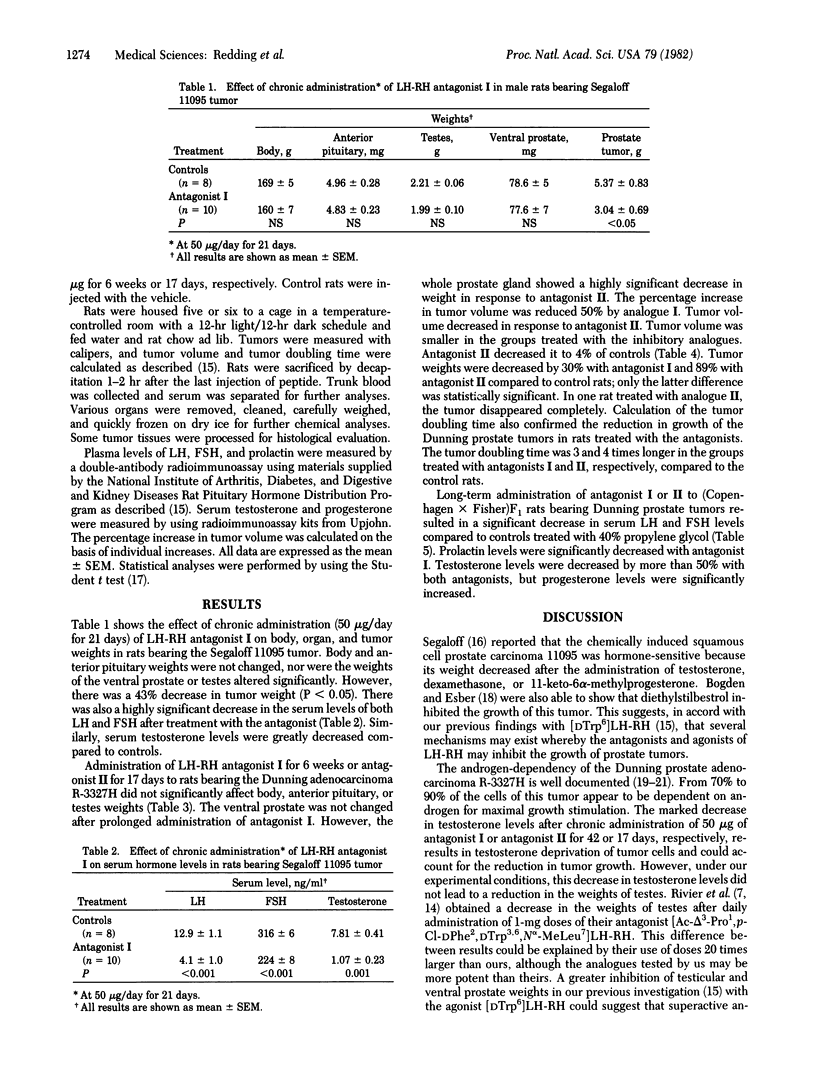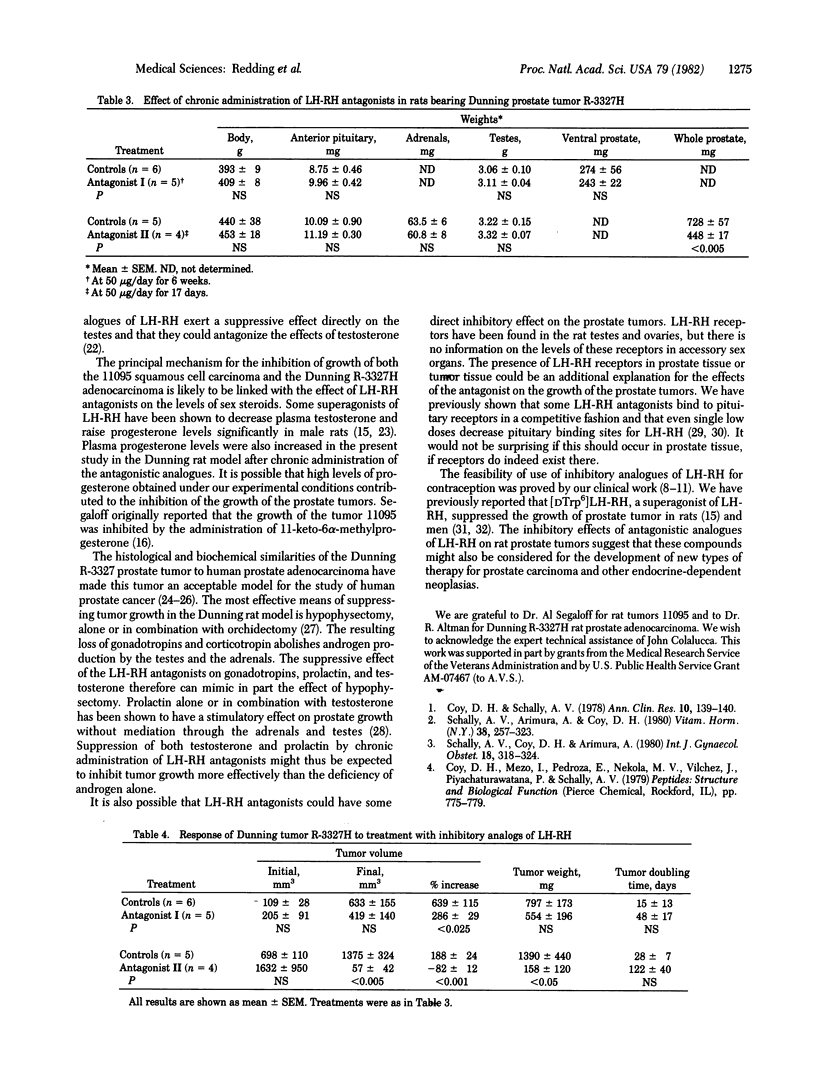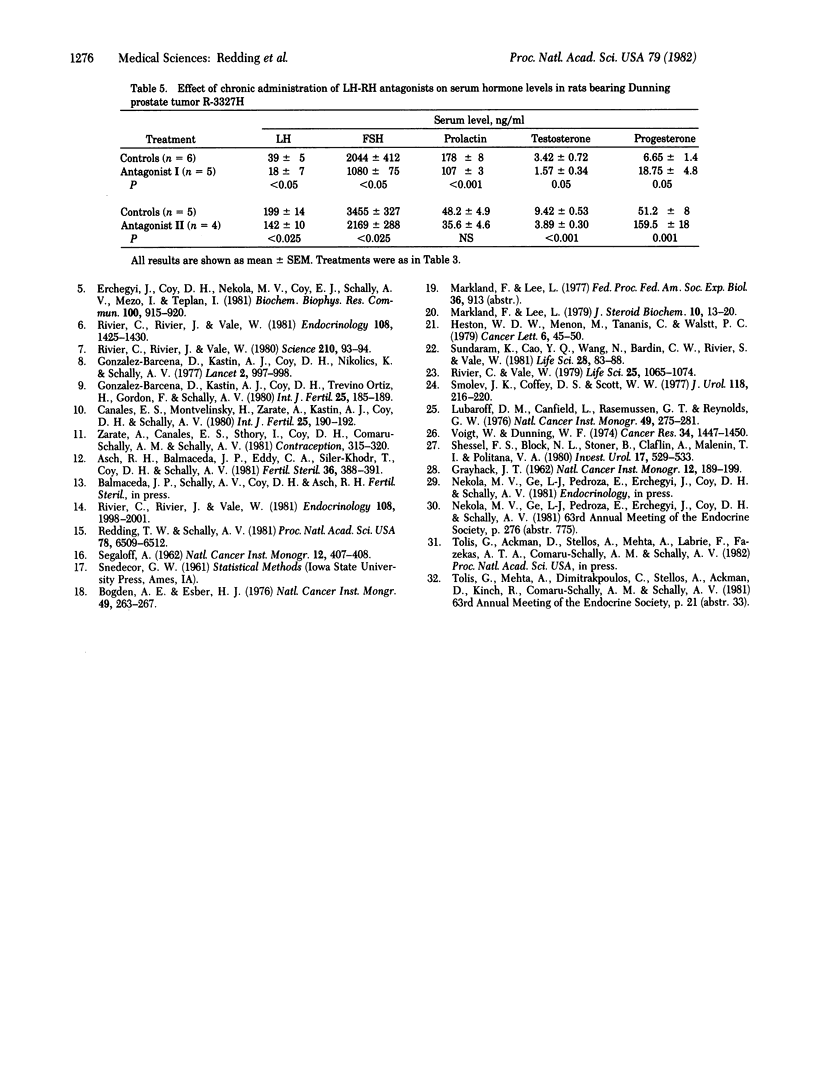Abstract
The effects of two potent antagonistic analogues of luteinizing hormone-releasing hormone (LH-RH) on the growth of two different models of rat prostate tumors have been investigated. Chronic administration of [NAc-p-F-DPhe1,p-Cl-DPhe2,DTrp3.6,D-Ala10]LH-RH (antagonist I) at 50 micrograms/day for 21 days significantly inhibited the growth of the chemically induced squamous cell carcinoma 11095 in Fisher 344 male rats. The weights of the pituitary, ventral prostate, and testes were not significantly altered. After 21 days of treatment with this analogue serum luteinizing hormone (lutropin), follicle-stimulating hormone, and testosterone levels were markedly decreased. When male Copenhagen F-1 rats bearing the Dunning 3327H prostate adenocarcinoma were injected with antagonist I at 50 micrograms/day for 6 weeks or with [NAc-p-Cl-DPhe1,2,DTrp3,DPhe6,DAla10]LH-RH (antagonist II) at 50 micrograms/day for 17 days, the percentage increase in tumor volume was decreased to half or less and the actual tumor volume was diminished 34-96% compared to controls. Tumor weight was decreased 30% and 89% after antagonist I and, respectively, compared to untreated controls. The tumor doubling time was 3- to 4-fold longer in rats receiving the inhibitory analogues than in the controls. Treatment with antagonist II decreased the weight of the whole prostate, but neither antagonist changed the weight of testes, anterior pituitary gland, or adrenals. Serum luteinizing hormone, follicle-stimulating hormone, and testosterone levels in Copenhagen F-1 rats bearing Dunning tumors were significantly decreased after treatment with the inhibitory analogues, but progesterone levels were increased. The inhibitory effects of these antagonistic analogues on rat prostate tumors suggest that these compound might be considered in the development of new types of therapy for prostate carcinoma and other endocrine-dependent neoplasias.
Full text
PDF



Selected References
These references are in PubMed. This may not be the complete list of references from this article.
- Asch R. H., Balmaceda J. P., Eddy C. A., Siler-Khodr T., Coy D. H., Schally A. V. Inhibition of the postcastration rise of luteinizing hormone and follicle-stimulating hormone in female rhesus monkeys (Macaca mulatta) by the administration of a luteinizing hormone-releasing hormone inhibitory analog ([N-Ac-D-Trp1-3,D-p-Cl-phe2,D-Phe6,D-Ala10]-LH-RH). Fertil Steril. 1981 Sep;36(3):388–391. doi: 10.1016/s0015-0282(16)45742-0. [DOI] [PubMed] [Google Scholar]
- Canales E. S., Montvelinsky H., Zárate A., Kastin A. J., Coy D. H., Schally A. V. Suppressive effect of an inhibitory LHRH analog on the gonadotropin response to LHRH in normal women. Int J Fertil. 1980;25(3):190–192. [PubMed] [Google Scholar]
- Coy D. H., Schally A. V. Gonadotrophin releasing hormone analogues. Ann Clin Res. 1978;10(3):139–144. [PubMed] [Google Scholar]
- Erchegyi J., Coy D. H., Nekola M. V., Coy E. J., Schally A. V., Mezo I., Teplan I. Luteinizing hormone-releasing hormone analogs with increased anti-ovulatory activity. Biochem Biophys Res Commun. 1981 Jun 16;100(3):915–920. doi: 10.1016/0006-291x(81)91910-0. [DOI] [PubMed] [Google Scholar]
- GRAYHACK J. T. PITUITARY FACTORS INFLUENCING GROWTH OF THE PROSTATE. Natl Cancer Inst Monogr. 1963 Oct;12:189–199. [PubMed] [Google Scholar]
- Gonzalez-Barcena D., Kastin A. J., Coy D. H., Nikolics K., Schally A. V. Suppression of gonadotrophin release in many by an inhibitory analogue of L.H.-releasing hormone. Lancet. 1977 Nov 12;2(8046):997–998. doi: 10.1016/s0140-6736(77)92893-8. [DOI] [PubMed] [Google Scholar]
- González-Bárcena D., Ortíz H. T., Gordon F., Kastin A. J., Coy D., Schally A. V. Influence of LH-RH agonists and antagonists on gonadotropin release in humans. Int J Fertil. 1980;25(3):185–189. [PubMed] [Google Scholar]
- Heston W. D., Menon M., Tananis C., Walsh P. C. Androgen, estrogen and progesterone receptors of the R3327H Copenhagen rat prostatic tumor. Cancer Lett. 1979 Jan;6(1):45–50. doi: 10.1016/s0304-3835(79)80019-1. [DOI] [PubMed] [Google Scholar]
- Lubaroff D. M., Canfield L., Rasmussen G. T., Reynolds C. W. An animal model for the study of prostate carcinoma. Natl Cancer Inst Monogr. 1978 Dec;(49):275–281. [PubMed] [Google Scholar]
- Markland F. S., Jr, Lee L. Characterization and comparison of the estrogen and androgen receptors from the R-3327 rat prostatic adenocarcinoma. J Steroid Biochem. 1979 Jan;10(1):13–20. doi: 10.1016/0022-4731(79)90135-3. [DOI] [PubMed] [Google Scholar]
- Redding T. W., Schally A. V. Inhibition of prostate tumor growth in two rat models by chronic administration of D-Trp6 analogue of luteinizing hormone-releasing hormone. Proc Natl Acad Sci U S A. 1981 Oct;78(10):6509–6512. doi: 10.1073/pnas.78.10.6509. [DOI] [PMC free article] [PubMed] [Google Scholar]
- Rivier C., Rivier J., Vale W. Antireproductive effects of a potent GnRH antagonist in the female rat. Endocrinology. 1981 Apr;108(4):1425–1430. doi: 10.1210/endo-108-4-1425. [DOI] [PubMed] [Google Scholar]
- Rivier C., Rivier J., Vale W. Antireproductive effects of a potent gonadotropin-releasing hormone antagonist in the male rat. Science. 1980 Oct 3;210(4465):93–95. doi: 10.1126/science.6774418. [DOI] [PubMed] [Google Scholar]
- Rivier C., Rivier J., Vale W. Effect of a potent GnRH antagonist and testosterone propionate on mating behavior and fertility in the male rat. Endocrinology. 1981 May;108(5):1998–2001. doi: 10.1210/endo-108-5-1998. [DOI] [PubMed] [Google Scholar]
- Rivier C., Vale W. Hormonal secretion in male rats chronically treated with [D-Trp6, Pro9-NEt]-LRF. Life Sci. 1979 Sep 17;25(12):1065–1074. doi: 10.1016/0024-3205(79)90592-7. [DOI] [PubMed] [Google Scholar]
- SEGALOFF A. DISCUSSION ON EXPERIMENTAL TUMORS; OBSERVATIONS ON A SQUAMOUS CELL CARCINOMA. Natl Cancer Inst Monogr. 1963 Oct;12:407–408. [PubMed] [Google Scholar]
- Schally A. V., Arimura A., Coy D. H. Recent approaches to fertility control based on derivative of LH-RH. Vitam Horm. 1980;38:257–323. doi: 10.1016/s0083-6729(08)60487-2. [DOI] [PubMed] [Google Scholar]
- Schally A. V., Coy D. H., Arimura A. LH-RH agonists and antagonists. Int J Gynaecol Obstet. 1980;18(5):318–324. doi: 10.1002/j.1879-3479.1980.tb00507.x. [DOI] [PubMed] [Google Scholar]
- Shessel F. S., Block N. L., Stover B., Claflin A., Malinin T. I., Politano V. A. Endocrine manipulation of the Dunning prostatic adenocarcinoma. Invest Urol. 1980 May;17(6):529–533. [PubMed] [Google Scholar]
- Smolev J. K., Coffey D. S., Scott W. W. Experimental models for the study of prostatic adenocarcinoma. J Urol. 1977 Jul;118(1 Pt 2):216–220. doi: 10.1016/s0022-5347(17)57949-5. [DOI] [PubMed] [Google Scholar]
- Sundaram K., Cao Y. Q., Wang N. G., Bardin C. W., Rivier J., Vale W. Inhibition of the action of sex steroids by gonadotropin-releasing hormone (GnRH) agonists: a new biological effect. Life Sci. 1981 Jan 5;28(1):83–88. doi: 10.1016/0024-3205(81)90369-6. [DOI] [PubMed] [Google Scholar]
- Voigt W., Dunning W. F. In vivo metabolism of testosterone-3H in R-3327, an androgen-sensitive rat prostatic adenocarcinoma. Cancer Res. 1974 Jun;34(6):1447–1450. [PubMed] [Google Scholar]
- Zarate A., Canales E. S., Sthory I., Coy D. H., Comaru-Schally A. M., Schally A. V. Anovulatory effect of a LHRH antagonist in women. Contraception. 1981 Sep;24(3):315–320. doi: 10.1016/0010-7824(81)90044-5. [DOI] [PubMed] [Google Scholar]


